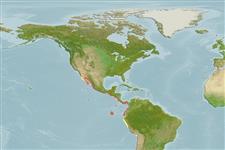Common names from other countries
Environment: milieu / climate zone / depth range / distribution range
Ecología
marino; salobre demersal; rango de profundidad 0 - 60 m (Ref. 9294), usually 0 - 28 m (Ref. 9294). Tropical; 33°N - 5°S, 116°W - 76°W (Ref. 56830)
Eastern Pacific: Gulf of California to Peru.
Tamaño / Peso / Age
Maturity: Lm ? range ? - ? cm
Max length : 26.5 cm TL macho / no sexado; (Ref. 124487); common length : 21.0 cm SL macho / no sexado; (Ref. 9294); peso máximo publicado: 166.13 g (Ref. 124487)
Short description
Claves de identificación | Morfología | Morfometría
Espinas dorsales (total) : 0; Radios blandos dorsales (total) : 98 - 109; Espinas anales: 0; Radios blandos anales: 82 - 92; Vértebra: 52 - 57. Body flat and elongated, with an oval anterior border; both eyes on left side; dorsal fin with 98 to 109 rays; anal fin with 82 to 92 rays; caudal fin with 12 rays; body light to dark brown, usually with 6 to 8 transverse bars of contrasting color; lower half operculum on the eyed side with a large dark stain; dorsal and anal fins progressively darker distally (Ref. 55763).
Common over muddy bottoms in estuaries and mangroves (Ref. 9294).
Life cycle and mating behavior
Maturities | Reproducción | Spawnings | Egg(s) | Fecundities | Larva
Munroe, T.A., F. Krupp and M. Schneider, 1995. Cynoglossidae. Lenguas, lenguetas. p. 1039-1059. In W. Fischer, F. Krupp, W. Schneider, C. Sommer, K.E. Carpenter and V. Niem (eds.) Guia FAO para Identification de Especies para lo Fines de la Pesca. Pacifico Centro-Oriental. 3 Vols. FAO, Rome. (Ref. 9294)
IUCN Red List Status (Ref. 130435)
CITES (Ref. 128078)
Not Evaluated
Threat to humans
Harmless
Human uses
Pesquerías: escaso valor comercial
Herramientas
Special reports
Download XML
Fuentes de Internet
Estimates based on models
Preferred temperature (Ref.
115969): 20.5 - 28.5, mean 25.1 (based on 102 cells).
Phylogenetic diversity index (Ref.
82804): PD
50 = 0.5000 [Uniqueness, from 0.5 = low to 2.0 = high].
Bayesian length-weight: a=0.01445 (0.00647 - 0.03228), b=3.05 (2.85 - 3.25), in cm Total Length, based on LWR estimates for this (Sub)family-body shape (Ref.
93245).
Nivel trófico (Ref.
69278): 3.4 ±0.4 se; based on size and trophs of closest relatives
Resiliencia (Ref.
120179): Alto, población duplicada en un tiempo mínimo inferior a 15 meses (Preliminary K or Fecundity.).
Fishing Vulnerability (Ref.
59153): Low vulnerability (21 of 100).
